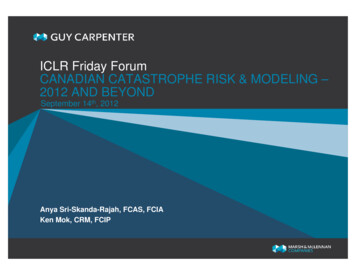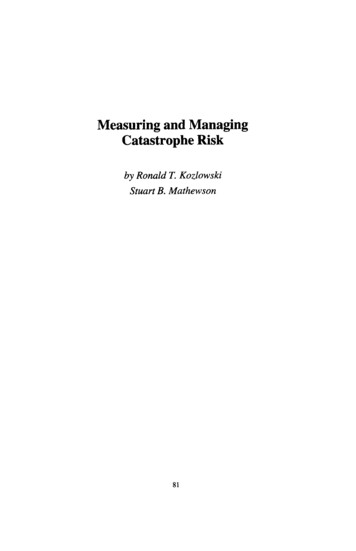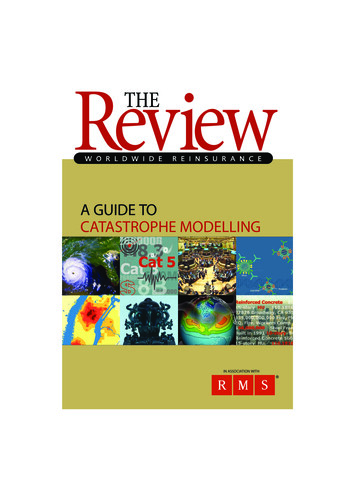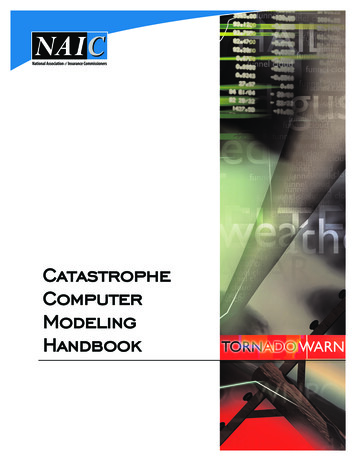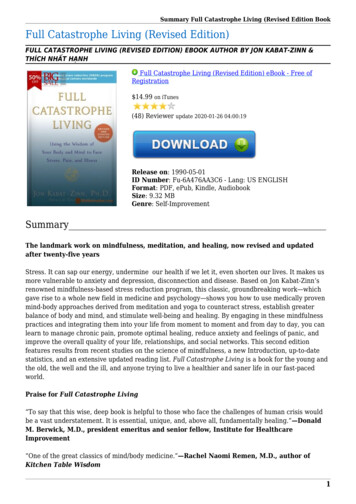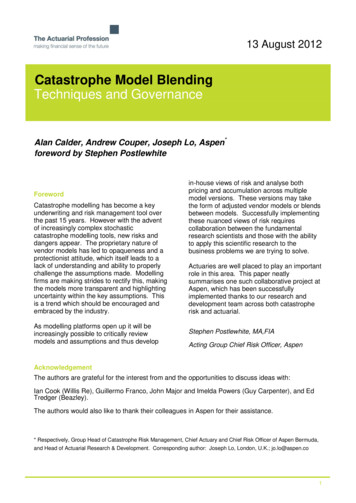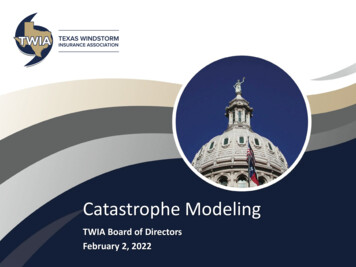
Transcription
Catastrophe Risk Management– Implications of Default Risk and Basis RiskAndreas RichterAssistant Professor of Risk and InsuranceUniversity of Hamburg, Germanyphone: 49 40 428384016, fax: 49 40 428385505richter@rrz.uni-hamburg.deFirst draft: May 29, 2002This draft: September 4, 2002
Catastrophe Risk Management– Implications of Default Risk and Basis RiskAbstractA major problem for insuring catastrophic risk is that, as a disaster causes damages tomany insureds at the same time, such insurance and in particular reinsurance contractsare often subject to considerable default risk. On the other hand, the securitization ofinsurance risk, for example via a catastrophe bond, can be designed to completely avoiddefault risk. In many cases, however, the payout from an insurance-linked security istied to some stochastic variable, an index, which is correlated, but not identical, with theinsured’s actual losses. Therefore, such an instrument will usually not provide a perfecthedge. There will be some mismatch, the so-called basis risk. This paper investigateshow the trade off between default respectively credit risk and basis risk affects optimalrisk management solutions, when (re)insurance and risk securitization are usedsimultaneously. In particular, the impact of credit risk and risk securitization on theoptimal reinsurance contract is analysed.Keywords: Insurance, Financial Markets, Alternative Risk Transfer, Decision Makingand RiskJEL-Classification: G10, G22, D81
11IntroductionThe temporary shortage of catastrophe reinsurance in the early 1990s, in particularfollowing hurricane Andrew,1 set off a search for alternative risk transfer (ART)solutions. The focus was primarily on tools that would enable a direct transfer of riskusing the financial markets, via so-called insurance-linked securities.2Capital market insurance solutions could be observed since 1992.3 At the end of 1992the Chicago Board of Trade (CBOT) started trading futures on catastrophe loss indexesand related options.4 These options, however, turned out not to be very successful.5Over the past few years, transfer of insurance risk via the financial markets has mainlybeen carried out using over-the-counter securities, such as, for example, catastrophebonds (cat bonds).A cat bond is a bond in which the interest and/or – depending on the specific design –the principal is (partially) forgiven when a pre-defined catastrophic event occurs. Thetypical structure of a cat bond issue is as follows:6 A special purpose vehicle (SPV) isset up, usually as an offshore reinsurer, its purpose solely being the handling of thatspecific securitization. The SPV reinsures the primary and backs up this contractthrough the issuance of the cat bond. The principal invested is held in trust. If no loss1See, in particular, Froot (2001), p. 540.2To motivate the interest in financial market solutions for the transfer of insurance risk, authors oftenrefer to the size of the financial markets or their daily fluctuations in comparison to the size of a majornatural catastrophe (see, e.g., Durbin, 2001, p. 305, Laster and Raturi, 2001, p. 13, or Durrer, 1996,pp. 4-5). For example, a USD 250 billion event would only represent less than 0.5% of the total marketvalue of publicly traded stocks and bonds of USD 60 trillion (Laster and Raturi, 2001, p. 13).3The total volume of transactions carried out since then exceeds USD 13 billion (Munich Re ARTSolutions, 2001, p. 11). Compared to the size of the reinsurance market, this is still not very significant.For example, the catastrophe excess of loss coverage purchased in the worldwide reinsurance marketin the year 2000 amounted to CHF 107 billion (Durbin, 2001, p. 301). The at first rapid increase in theuse of financial catastrophe risk management tools halted in the late 1990s after a decrease inreinsurance prices (see Laster and Raturi, 2001, p. 18). Particularly the consequences of September11th on reinsurance capacity and pricing, however, might cause the growth of the market forinsurance-linked securities gain speed again.4See Albrecht, König, and Schradin (1994), Durrer (1996), pp. 9-11, Wagner (1997), pp. 514-516.5See Müller (2000), p. 216, and Laster and Raturi (2001), p. 5. However, it seems likely that, mediumterm, derivative instruments can play an important role for catastrophe risk transfer (see Laster andRaturi, 2001, p. 17). At the moment, similarly structured instruments receive attention in a relatedfield: The hedging of weather risk. In areas of business for which success heavily depends on weatherconditions, companies, as for example energy providers, try to hedge these risks through weatherderivatives (see Müller, 2000, pp. 217-221).6See, e.g., Belonsky, Laster, and Durbin (1999), p. 5.
2occurs, principal and interest are paid back to the investors, whereas in case of a lossthis amount is reduced by the coverage that goes to the primary.7Cat bonds have had the biggest market share among recent insurance risk securitizationtransactions.8 These bonds are mainly used by primary insurers and reinsurers tosubstitute or supplement traditional reinsurance or retrocession. It has to be emphasized,however, that such instruments can, of course, also be attractive risk management toolsfor companies from other branches. As an example, reference can be made to the catbond hedging earthquake risk that was issued by Tokyo Disneyland in 1997.9One economic rationale for the attractiveness of certain kinds of risk transfer throughthe financial markets is that, in contrast to traditional (re)insurance products, theseinstruments can be designed in such a way as to avoid – or substantially reduce – defaultrisk (credit risk).10 For instance, the capital invested in a catastrophe bond is provided exante and is therefore in any case available when a catastrophe occurs that triggers thecoverage.11, 12This is an important feature since, in particular, natural disaster hazards often impose asignificant insolvency risk for reinsurance companies active in that business, implyingthat their contracts are subject to default risk. The problem mainly arises from thepotential of a regional accumulation of losses as it is typically incurred by catastrophicevents. The threat of loss accumulation leads to high correlation between the differentlocal primaries’ portfolios and, therefore, between claims from different contracts in a7For a more comprehensive discussion of insurance risk securitization design possibilities as well as fordata concerning recent transactions in this field see, e.g., Durrer (1996), Wagner (1997), Albrecht andSchradin (1998), Baur and Schanz (1999), Belonsky, Laster, and Durbin (1999), and Laster and Raturi(2001).8See Laster and Raturi (2001), p. 19.9See Müller (2000), pp. 215-216.10See, e.g., Croson and Kunreuther (2000), pp. 30-31, Albrecht and Schradin (1998), p. 601, Laster andRaturi (2001), p. 14.11More precisely, the funds are usually invested in investment-grade securities and guaranteed by ahighly rated company (see, e.g., Laster and Raturi, 2001, p. 14). This implies that contingent capitalgenerated through issuance of a cat bond is – if at all – subject only to very little default risk.12The use of catastrophe options also avoids default risk to a great extent, as usually obligations areguaranteed by the exchange (see, e.g., Laster and Raturi, 2001, p. 18).
3reinsurer’s portfolio. For the single primary insurer, this leads to an increased defaultrisk with respect to catastrophe reinsurance.13While default risk can be reduced or avoided through certain risk securitizationinstruments, this advantage is often tempered by another typical feature of such tools: Inmany risk securitization transactions the coverage does not directly depend on thehedging insurer’s actual losses but on some other random variable which is correlatedwith the losses. For instance, the contingent payment from a cat bond can be tied to a(regionally defined) market loss index, or it can be based upon technical parametersdescribing the intensity of a catastrophic event (parametric trigger). Examples for thelatter kind of an underlying are the Richter scale reading of an earthquake or thestrength of a hurricane, observed in a certain region over a certain period specified bythe contract.The main advantage of market indexes or parametric triggers, besides their contributionto alleviate standardization, is the fact that, compared with reinsurance, they are largelyor even completely out of the primary’s control.14 Therefore, the use of these underlyingrandom variables offers an instrument to address moral hazard, which is a problem inalmost every insurance relationship. It can be observed in primary insurance, but also inthe relationship between a primary insurer and its reinsurer: A primary is in charge ofrisk selection and monitoring as well as settling losses with its customers. Consideringthe fact that it would normally be impossible or prohibitively expensive for the reinsurerto monitor these activities, reinsurance relationships will usually be characterized byasymmetric information. As a consequence, a primary’s carefulness can be expected todecrease in the amount of its reinsurance coverage.If, on the other hand, the trigger is a market loss index, moral hazard is limited to theprimary’s contribution to the index. By making use of a parametric trigger the moral13An illustrative example for the realization of default risk was hurricane Andrew which lead to anumber of insolvencies in the reinsurance market. The following years were also characterized by amassive drop of the number of reinsurance companies due to a series of mergers and acquisitions (seeHolzheu and Lechner, 1998). Considering that major factors determining a reinsurer’s risk ofinsolvency are its worldwide spread and financial strength, this tendency of consolidation might –among other issues – also be a consequence of a growing awareness of default risk. See also Lasterand Raturi (2001), p. 14: That default risk is an issue in reinsurance contracting is also reflected bymarket shares. In 1999, for example, among the world’s 100 biggest reinsurance companies, only 20%of premiums were written by companies rated (by Standard & Poor’s) below AA.14A parametric trigger has the additional advantage that the relevant numbers are usually available veryquickly. Contrasting this, a market index typically needs a long time until it is fully developed, inparticular due to time-consuming problems of loss-settling.
4hazard problem can even be avoided. However, the reduction or elimination of moralhazard incurs a certain cost. Typically, the less the underlying random variable can beinfluenced by the primary, the less useful is the contingent coverage as a hedgingvehicle. The resulting mismatch between the loss and the coverage is called basis risk.For instance, the payment from a cat bond might not be triggered by an earthquake,since its strength is too low, even though substantial damages are caused in theprimary’s portfolio. On the other hand, a realization of basis risk could be that coveragefrom the cat bond is actually paid to the hedging primary although no significantindividual losses are observed from that particular event.This paper will analyze the way in which default risk (respectively, credit risk) and thecombined occurrence of default risk and basis risk affect risk management decisions. Ofparticular interest is the impact of these risk components on the structure of optimalreinsurance arrangements.So far, the demand for catastrophe coverage, provided through the new financial instruments, has been addressed by means of formal analyses only in a few papers: Forexample, Doherty and Mahul (2001) and Doherty and Richter (2001), investigate thetrade-off between moral hazard and basis risk, when insurance can be used to insure thebasis risk. It is shown that combining the two hedging tools might extend the possibilityset and therefore lead to efficiency gains.15 While these papers are concerned with aninsurance coverage that is based upon an index-linked product, Nell and Richter (2001)consider optimal risk management solutions for the case where both tools can be usedindependently. They study the trade-off between the implicit transaction cost incurredby a reinsurer’s risk aversion and the basis risk of a cat bond. In the following, a modelwill be used which modifies the framework introduced by Nell and Richter (2001) byincorporating default risk.The impact of default risk on the demand for insurance, or respectively, on optimalinsurance contracting has been addressed by Schlesinger and Schulenburg (1987) andDoherty and Schlesinger (1990). They show that certain important results frominsurance demand theory do not hold when default risk is taken into account.15As the combined product could easily be replicated by a reinsurance company that would use an indextrigger in addition to the usual indemnity trigger (i.e. the primary insurer’s actual loss), the results canalso be interpreted as a product design recommendation for reinsurers.
5In a recent paper on this topic, Cummins and Mahul (2000) consider an insuranceproduct that is subject to default risk as well as basis risk, since the insurer’s payment istied to an exogenous index. As mentioned above, the interaction between these twofactors is also the topic of this paper. The focus, however, is different here, since, incontrast to Cummins and Mahul (2000), a situation is considered with two differentinstruments (using different triggers): Insurance, on the one hand, is subject to defaultrisk but can be used to generate a perfect hedge. Risk securitization, on the other hand,comes without default risk but incurs basis risk.The remainder of the paper is organized as follows: The model is introduced in the nextsection. Section 3 presents the results, and section 4 briefly summarizes the mainfindings.2The ModelConsider the risk management decisions of a primary insurer with an initial risk situation X . Assume that the (nonnegative) random variable X is continuouslydistributed with density functionf (x) . The primary insurer is risk-averse and maxi-mizes its expected utility. u1 denotes the (three times continuously differentiable)primary’s utility function ( u1′ 0 , u1′′ 0 ).16The primary insurer can purchase traditional reinsurance or index-linked coverage orboth. Let us first introduce reinsurance: A reinsurance contract will be characterized byan indemnity function, I (x) , that assigns the amount of indemnity to the realization x of the random variable X , the premium, Π , and the reinsurer’s credit risk. The last is therisk that the indemnity from the reinsurance contract would not be available when a lossoccurs. It is expressed through the function of conditional probabilities that the reinsurergoes bankrupt and therefore cannot compensate the primary, given the amount of theprimary’s actual loss (x): These probabilities are denoted by 1 p R (x) . Thus, p R (x) isthe probability that the primary receives the coverage from the reinsurance contract,given x. We assume that the function p R (x) is continuously differentiable anddecreasing in x ( p ′R ( x) 0 ).
6This assumption reflects that reinsurance default risk is typically correlated with theindividual primary’s actual losses from catastrophic events. Consider the example of aCalifornian primary insurer with a regionally concentrated book of business, wanting toprimarily reinsure the catastrophic consequences of a major earthquake. The primarywould have to take into account that the likelihood of the reinsurer actually coveringlosses in accordance with the contract would, at least, not be increasing in the primary’sactual losses. This is due to the risk of an accumulation of insured losses in thereinsurer’s portfolio: The primary’s individual losses from catastrophic events would behighly correlated with the losses of other primaries, particularly in the same localmarket. In case of a catastrophe the reinsurer’s capacity, thus, would at the same time beneeded for a multitude of its customers.Clearly, the extent of credit risk, and in particular the shape of the function p R (x) ,crucially depends on the degree of regional diversification in the reinsured portfolio.17The limiting case is that the reinsurance company has only very little exposure tocatastrophic loss in a certain area, such that here the probability of default is constant inx ( p ′R ( x) 0 x ).As the interdependence between the individual primary’s losses and default risk iscertainly characteristic for most catastrophe reinsurance relationships, it is interesting toanalyze the impact the resulting correlation has on optimal catastrophe reinsurancecontract structure. The model frameworks used by Schlesinger and Schulenburg (1987)and Doherty and Schlesinger (1990) assume two-point loss distributions, and, therefore,cannot be employed to derive results concerning how credit risk affects the optimalindemnity scheme. So, with respect to the mere insurance demand theory point of view,the more general approach chosen here does not only allow for a generalization ofcertain results. It also enables an analysis of specific aspects of catastrophe(re)insurance demand. That – of course – will just be the first step, as we are primarilyinterested in the interaction between index-linked coverage and reinsurance.16For a discussion of adequate assumptions concerning risk attitudes in entrepreneurial decision-making,see, among many others, Greenwald and Stiglitz (1990), Dionne and Doherty (1993), or Nell andRichter (1996).17Obviously, a reinsurance company’s bankruptcy risk also depends on other factors besides thestructure of its insured portfolio. In particular, the size of the reinsurer’s own capital funds and its ownreinsurance or retrocession policy are important determinants. In the model, these aspects would affect
7Assume that all actors in the market possess complete information, implying there areno moral hazard problems. Furthermore, to keep the analysis as simple as possible, wewill discuss the trade-off between basis risk and credit risk under the assumption thatreinsurance incurs no transaction costs. In particular this means that the reinsurer isassumed to be risk-neutral.Under these assumptions, the reinsurance premium in a competitive market can becalculated as follows: (1)Π p R ( x) I ( x) f ( x)dx.0 The price of reinsurance equals the expected value of the random variable I ( X ) ,corrected by a reduction that reflects default risk.The reinsurance contract can be supplemented or substituted through index-linked coverage H 0 , which is triggered if an exogenous index Y reaches or exceeds acertain level y (since this kind of product is usually defined discretely, we concentrate– without major loss of generality – on the simple case of a stochastic variable with only the two possible outcomes 0 and H). The correlation between Y and X is expressed bythe function of conditional probabilities p H ( x) : P{Y y X x}(2) (if a certain outcome is not specified, we also write p H ( X ) ). Let p H E[ p H ( X )] . ( E[ ] denotes the expectation with regard to the distribution of X.)In the absence of transaction costs the index-linked product is sold in a competitivemarket at a rate that equals the expected payment, p H H .Assume that p H (x) vanishes for sufficiently small x, and that p H ( x) 1 for sufficientlylarge losses, and finally that there is an area where the trigger probability is strictlythe shape of the function p R (x ) and in particular the component of credit risk which is “independent” of X (1 p R ( 0)) .
8between 0 and 1 and increasing. To formalize this, we say that potential levels of loss x1and x2 ( x1 x 2 ) exist such that18(3)p H ( x) 00 p H ( x) 1p H ( x) 1x x1x1 x x 2x x2 .The intuition behind this is as follows: If the primary is only hit by a very small amou
So far, the demand for catastrophe coverage, provided through the new financial instru-ments, has been addressed by means of formal analyses only in a few papers: For example, Doherty and Mahul (2001) and Doherty and Richter (2001), investigate the trade-off between moral hazard and basis risk, when insurance can be used to insure the basis risk.
